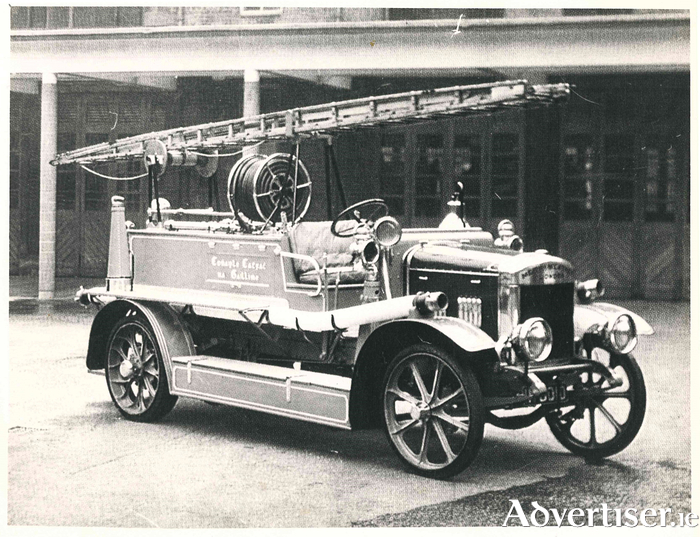Moses Merryweather and his son Richard lived in Clapham, London and they worked with the engineer Edward Field on putting his design of a vertical boiler onto a horse-drawn platform.
They successfully applied it for use in their steam fire engine thus improving water pressure and making it easier to use, once steam had been got up. It was reckoned that the engine could get up enough pressure to pump within ten minutes of a call out.
The fire could be started before leaving the station so there could be enough pressure by the time they arrived at the scene of the fire. In 1899, Merryweather produced the first successful self-propelled steam fire engine. Appliances were available in small sizes suitable for a country house pumping around 100 gallons per minute. A common size, popular with Borough Fire Brigades was the double vertical boiler that could pump between 250 and 400 gallons per minute.
This was the model purchased by Galway County Council in December 1928. It was built on an Albion “D” type chassis. The Albion petrol engine is a four cylinder unit, three and seven eights inch bore by five inch stroke. A 250 gallon per minute Hatfield pump is fitted at the rear of the machine and is driven through a reduction gearbox with a ratio of approximately 1:375.
It had solid wheels and was known as a ‘retained’ fire brigade, not a permanent one. The legend “Comhairle Cathrach na Gaillimhe” was painted on the sides. The registration number was IM 3010. It used to be kept in the old Fire Brigade headquarters in Bowling Green and that is where our photograph of the machine with the crew was taken c.1930.
Most of them were volunteers and obviously had not been issued with uniforms as yet. If they had protective gear, they did not bring it out for the photograph. It was driven initially by Frank Dolan and subsequently by his son Jim. Notice the bell mounted on the front of the vehicle, this was for ringing to warn traffic to get out of the way as they rushed to the scene of a fire.
The Merryweather remained in service here until 1966 when it was exchanged for a redundant turntable ladder by Glasgow Fire Service. They completely restored it in their Fire Service workshops and it was presented to the Museum of Transport in Glasgow in 1968. It is their pride and joy and is on permanent display there as can be seen from our photograph which was taken in 1968.
The committee who were instrumental in buying the machine for Galway were – Mr. Colgan, Mr. Martin Cooke, Mr. Jackson, T. Duggan, Town Steward, Martin Redington, Patrick Broderick, William Sammon, James Redington, Frank Kelly, Jack Browne, William Binns, John Connolly, S. Lee, John Coogan, F. Lydon, Eyre Street, Michael O’Flaherty, Gilbert Lynch, Trade Unions, Joe Young and Frank Dolan.
In 1907, the Public Health Act enabled local authorities to enter into agreements for the common use of fire-fighting equipment. A fire service was set up here and all of the early firefighters were volunteers. In 1911, a Mr. Cunningham was trying to set up a proper fire Brigade. We are not sure when exactly it was officially set up and if you have any information on it, Frankie Dolan in the Fire Station would love to hear from you.
The members of Galway Fire Brigade are among the unsung heroes we have in Galway, working selflessly to save lives and buildings when fires occur, putting out bog fires, cutting open wrecked vehicles when accidents occur, recovering bodies from the river and the sea. More than that, they often do a lot of work and fundraising for local charities.
Again, as we start a new year, I would like to sincerely thank all those who read this column, for their encouragement and support over the last year. A happy New Year to you all.

